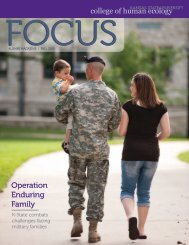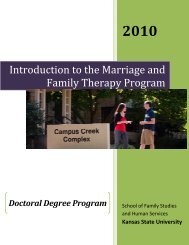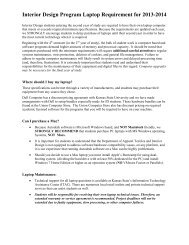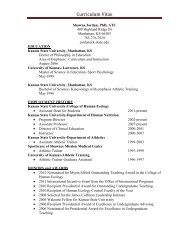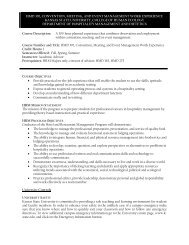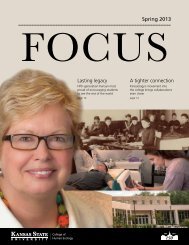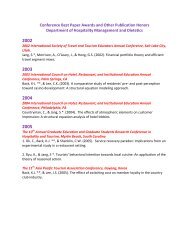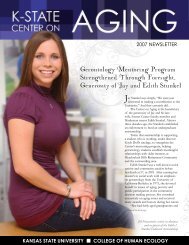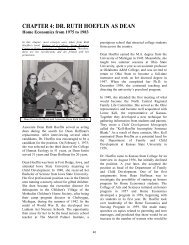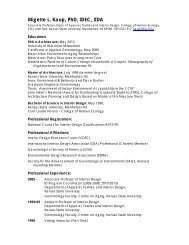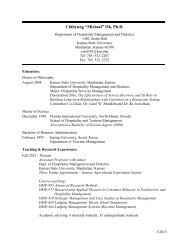Winter 2007 - College of Human Ecology - Kansas State University
Winter 2007 - College of Human Ecology - Kansas State University
Winter 2007 - College of Human Ecology - Kansas State University
- No tags were found...
Create successful ePaper yourself
Turn your PDF publications into a flip-book with our unique Google optimized e-Paper software.
departmentheadworks to improve accessto higher educationDenis Medeiros, head <strong>of</strong> the Department <strong>of</strong> <strong>Human</strong>Nutrition, is an expert in trace elements and howthey affect cardiac health. He still loves to cookthe traditional foods he grew up eating, and he enjoys agood run around CiCo park in Manhattan. But when hetalks about how everybody who wants to work and study atK-<strong>State</strong> should get a fair shake, you figure out that matters<strong>of</strong> diversity are also very close to his heart. And in 2006,Medeiros and the Department <strong>of</strong> <strong>Human</strong> Nutrition (HN)earned a lot <strong>of</strong> recognition for their efforts to promotediversity among their faculty and students.In June, <strong>Human</strong> Nutrition was recognized by theK-<strong>State</strong> Provost’s Office with the <strong>University</strong> OutstandingDepartment Award for Enhancing Diversity. Along with aplaque came a $2,500 award that the HN faculty and staffpromptly reinvested in the K-<strong>State</strong> Developing Scholarsprogram (which places minority students in research projectswith faculty mentors) and a project to translate K-<strong>State</strong>Research and Extension health and nutrition materials intoSpanish.“Of all the awards I have received or been associatedwith in my career, this is the one that I am and will beproudest <strong>of</strong>,” Medeiros said at the time.Of course, that was before Edgar Chambers IV,pr<strong>of</strong>essor <strong>of</strong> human nutrition and director <strong>of</strong> the SensoryAnalysis Center, nominated Medeiros for the K-<strong>State</strong>Research and Extension Diversity Award, which hereceived in September.“This was a total surprise to me. Edgar didn’t sayanything about it. I didn’t know I was even nominateduntil I got the letter from Fred Cholick (dean <strong>of</strong> the<strong>College</strong> <strong>of</strong> Agriculture and director <strong>of</strong> K-<strong>State</strong> Researchand Extension) saying I’d won!” Medeiros recalled.Medeiros is especially proud that the HN faculty andstaff are addressing the need for diversity on a variety<strong>of</strong> fronts.“I’m proud that our hiring practices have broughtus a good gender balance and many talented peoplefrom all kinds <strong>of</strong> backgrounds — Asian, Latino,African-American, Indian. We are improving inattracting diverse and talented students every year.And our Extension programs target minority andpoor populations across <strong>Kansas</strong> to help families livehealthier lives.”Of particular note is the <strong>Kansas</strong> Bridges to theFuture program, a partnership between K-<strong>State</strong>and five <strong>Kansas</strong> community colleges to shepherdstudents from underrepresented groups intocareers in the biomedical field after they earn theirbachelor’s degrees. The program has been sponsored by theNational Institutes <strong>of</strong> Health and provides full tuition foreligible students. Since 2004, 24 students have successfullytransferred from community colleges to K-<strong>State</strong> through theBridges program.Medeiros grew up in Hartford, Conn., the son <strong>of</strong> theonly Spanish-speaking police <strong>of</strong>ficer in town. His father’sexperiences gave him an early understanding that organizationsbenefit by including people from a variety <strong>of</strong> backgrounds.“Dad used to get calls when he was supposed to be <strong>of</strong>fduty,and he’d go down to the police station to translate forsomebody who’d been brought in, because nobody else onthe force could talk to the person,” Medeiros remembered.Medeiros, who has always made his living by studyingfood and how it affects humans, noted that even when thenative language disappears from one generation to the next,traditions that revolve around food persist.“Language gets lost. Food doesn’t. That’s especially goodinformation for dietitians and other people who care aboutnutrition to remember. People will pass on their recipes totheir kids, and dietitians and nutritionists can build on thoserecipes and traditions to encourage healthier eating.”If you would like to learn more about how you could invest inopportunities for students through the <strong>Kansas</strong> Bridges to the Futureprogram, please contact Jennifer Rettele-Thomas at jenniferr@found.ksu.edu or 800-432-1578.<strong>Winter</strong> <strong>2007</strong>
RememberingFriends increaseMuseum’sholdingsdesigned by a<strong>Kansas</strong> fashionlegend FocusPhotos courtesy <strong>of</strong>Terence Michael O’MalleyThe K-<strong>State</strong> Historic Costume and TextileMuseum takes great pride in having morethan 15,000 historic clothing and textileitems from countries and cultures around the globe.But as part <strong>of</strong> the Museum’s mission, it has putspecial emphasis in acquiring and preserving clothingand textiles associated with <strong>Kansas</strong> history.With this in mind, the Museum recentlyrecognized a major gap in its collection: a lack <strong>of</strong>dresses bearing the Nelly Don label. This is ironic,considering Nelly Don was a garment industryempire <strong>of</strong> the first half <strong>of</strong> the 20th century basedin <strong>Kansas</strong> City and founded by Parsons-born Ellen“Nell” Donnelly and her first husband, Paul.Nelly Don is significant to the history <strong>of</strong>American fashion because she made pretty,affordable and practical clothing that defied earlierconventions <strong>of</strong> female domesticity. As a younghousewife, Nell started her business simply becauseshe herself didn’t want to wear boring “MotherHubbard” housedresses. She began making clothingfor family, friends and neighbors, who soonencouraged her to sell them. Her lucky break camein 1916 when Peck’s Dry Goods Store in <strong>Kansas</strong>City ordered 18 dozen dresses and launched hercompany.Naming her label “Nelly Don” by joining pieces<strong>of</strong> her and her husband’s names, Ellen assumedthe name herself so that every time her name wasspoken, her dresses would be promoted. And itworked. While she built her empire, she also built
her own celebrity, creating a reputation for herself as one <strong>of</strong>the first and most successful self-made women millionairesin American business. She designed and sold more dressesin the 20th century than any single other person in theUnited <strong>State</strong>s. By 1949, the company posted $14 million insales, making dresses that sold in stores across the nationfor between $4 and $13 each. At that time, Nelly Don wasthe single largest dress manufacturing plant in the world,covering two <strong>Kansas</strong> City blocks.Marla Day, curator for the Historic Costume andTextiles Museum, said that Nelly Don’s attention to detail,quality and workmanship forever changed Americanclothing design.In addition to the housedress, Nelly Don is alsoremembered for contributions toAmerican fashion and historyduring World War II.During the war, shedeveloped one-piece,Rosie the Riveter-stylework coveralls for womenwho worked in industryand uniforms for Americanservice women.As a businesswoman, theway she ran her company andcared about her employees— <strong>of</strong>fering benefitssuch as day care, tuitionmoney, good workingconditions, an on-siteinfirmary, a clubhouseand farm exclusivelyfor employee activities,and a reasonably pricedcafeteria — made herahead <strong>of</strong> her time.“She was such a pioneer in <strong>Kansas</strong>,” Day said. “Shedeserves a special place in the collection because <strong>of</strong> herinnovative marketing strategies and her progressive supportfor working women.”But it’s the drama <strong>of</strong> her personal life that makesthe Nelly Don story legendary. Her first husband, Paul,suffered from depression and <strong>of</strong>ten threatened to commitsuicide if Nell were to become pregnant. He later becamean alcoholic and the couple grew apart. While still marriedto Paul, Nell began an affair with married U.S. SenatorJames A. Reed. In September 1931, she traveled to Europeostensibly to adopt a child. In truth, while in Europe shebore a healthy son to Reed.Three months after returning to <strong>Kansas</strong> City, she andher chauffeur were kidnapped in front <strong>of</strong> her home. Reedcame to her rescue, threatening the kidnappers that if they“harmed a hair on her head” he would track them downand ensure they’d get the death penalty. Reed then contactedNelly Don dressespurchased byFriends group<strong>Kansas</strong> City gangster Johnny Lazia and ordered him to findNell within 24 hours or else Reed would buy national radiotime to expose Lazia’s illegal operations. So, Lazia sent 25carloads <strong>of</strong> gangsters who did find and rescue Nell.Nell lived to be 102 years old, outliving all 12 <strong>of</strong> herbrothers and sisters and dying 47 years to the day after Reeddied. Her life was recently brought to the silver screen in adocumentary titled “A Stitch in Time.” A companion websiteand book are available at www.nellydon.com.“She’s absolutely fascinating,” Day said. “There was a lot<strong>of</strong> interest in her when the book and movie came out, whichbrought her to the forefront. We knew we had to have some<strong>of</strong> these pieces in the collection.”The Friends <strong>of</strong> the K-<strong>State</strong>Costume and TextileMuseum are leadingan initiative to bringNelly Don to K-<strong>State</strong>.Recently the grouppurchased four dressesand donated them to theMuseum, a first for thegroup that was foundedto help publicize theMuseum and raisefunds to improve andexpand its facilitiesand staff. The dresseswere purchased withproceeds from pastfund-raising events.The Friends hopetheir gift will inspireothers to donate NellyDon dresses that maybe packed away in cedarchests and family attics.High on the Museum’s wish list areearly garments made by the Donnelly Garment Company;Handy Dandy Aprons, which sold in the millions duringthe Depression and kept the company afloat; and Donall,“scientifically planned,” utilitarian work garments for womenmade during the World War II era.Mary Don Peterson, president <strong>of</strong> the Friends andemeritus pr<strong>of</strong>essor <strong>of</strong> Apparel, Textiles, and Interior Design,encourages anyone with an existing Nelly Don dress tocontact the museum, regardless <strong>of</strong> its condition. She saidthere is an unfounded perception that because these dresseswere worn for work around the home — and <strong>of</strong>ten showsigns <strong>of</strong> wear — that they are unworthy <strong>of</strong> a place in amuseum.“These dresses are integral to the history <strong>of</strong> fashionin <strong>Kansas</strong> — and the nation,” Peterson said. “Nelly Donis important because her company addressed the needs <strong>of</strong>women at the time. We hope to increase our holdings so thatContinued on back cover<strong>Winter</strong> <strong>2007</strong>
Get ’Em WhenThey’re YoungWebsite helps parents, communities setyoung people on the path to a healthy lifeEat a lot <strong>of</strong> carbs. No, carbs are terrible for you! Eatred meat for the iron and B vitamins. No, don’t, ithas too much fat! Exercise so hard you “feel theburn.” No, exercise at a moderate level, and you’ll get results.What’s a health-conscious consumer to do?A grant-funded website uniquely focused on the needs<strong>of</strong> Kansans is here to help. As it says on the homepage(www.knackonline.org), KNACK (Knowledge <strong>of</strong> Nutritionand Activity for Communities in <strong>Kansas</strong>) is an innovativewebsite designed “to help parents, community advocates, andyouth workers address adolescent overweight and obesitythrough evidence-based, reliable, useful and action-orientedresources.” Focus
The health and family experts in the <strong>College</strong> <strong>of</strong> <strong>Human</strong><strong>Ecology</strong> recognize that the key to a long and healthy life isto develop good habits, and the younger, the better. Facultyin the Department <strong>of</strong> <strong>Human</strong> Nutrition and the School <strong>of</strong>Family Studies and <strong>Human</strong> Services have collaborated ona site that promotes good nutrition and physical activity inyoung people.“Research has shown that if you can get kids to establishhealthy eating and physical activity habits, they are likely tomaintain those habits over a lifetime,” said Denis Medeiros,head <strong>of</strong> the Department <strong>of</strong> <strong>Human</strong> Nutrition and principalinvestigator on the KNACK grant. “The younger the personis when he or she adopts good habits, the more likely it isthat those habits will stick.”“In early 2005, through the efforts <strong>of</strong> formerCongressman Jim Ryun and former Dean Carol Kellett,we were awarded $248,000 in a grant from the Centers forDisease Control to set up the website,” Medeiros continued.“We set up a KNACK Council <strong>of</strong> health advisors andorganizations from all over <strong>Kansas</strong> — registered dietitians,physicians, K-<strong>State</strong> researchers, health advocacy groups andstate agencies. They worked closely with us to establish ourgoals and they continue to help us evaluate our content andhow we present it.”Although KNACK began with grant funding, itscontinuing impact has been ensured through recentcontributions from the Sunflower Foundation and theUnited Methodist Health Ministry Fund.“Our long-term goal is to stem obesity in <strong>Kansas</strong>,”Medeiros said. “We are now researching how we might workwith particular communities to track how they use KNACKand whether the site helped them cut obesity in theirpopulations. This is a pretty l<strong>of</strong>ty goal, but we think that thesite has that potential.”And by the way, eat most <strong>of</strong> your carbs as fruits, veggiesor whole-grains. Enjoy that steak, just trim the fat. And 30minutes <strong>of</strong> moderate exercise, spread throughout your day,will have a lot <strong>of</strong> health benefits. According to KNACK,any physical activity “counts,” so that means gardening,biking, walking, dancing…even mowing. So dust <strong>of</strong>f thepush mower and get moving!Please visit www.knackonline.org, and feel free to link toKNACK from your own website! If you have questions or comments,please e-mail them to simonson@k-state.edu.www.knackonline.orgThe information on KNACK is solid, evidence-basedscience. The programs and health recommendations on thesite have a track record <strong>of</strong> good data to back them up. Thesite is organized by “who you are”: parent, adult youth leaderor community advocate.“We really worked hard to determine which groupscould realistically make the biggest impact on the health <strong>of</strong>children and teens,” Lawrence Simonson, project manager,said. “Parents are an obvious choice, but there are a lot <strong>of</strong>other people in a community who influence young people.4-H leaders, Boy and Girl Scout leaders, church youth groupdirectors and a lot <strong>of</strong> others can all help make a difference.They can set a good example and reinforce what kids shouldbe hearing at home about living a more healthy life.”Community advocates are public <strong>of</strong>ficials who impactlocal decision making. For instance, city council members,parks and recreation personnel, and school board membersall have the power to drive a public agenda that promotesgood nutrition and physical activity.Besides Medeiros and Simonson, the K-<strong>State</strong> KNACKteam consists <strong>of</strong> Elaine Johannes, Ph.D., assistant pr<strong>of</strong>essorand Extension specialist, School <strong>of</strong> Family Studies and<strong>Human</strong> Services; Tanda Kidd, Ph.D., R.D., L.P.N., assistantpr<strong>of</strong>essor and Extension specialist, Department <strong>of</strong> <strong>Human</strong>Nutrition; and <strong>College</strong> webmaster Nate Dillon.<strong>Winter</strong> <strong>2007</strong>
‘It’s been a great ride.’Stone House legend prepares to retire after 30 years at K-<strong>State</strong>Awail brought a smile to Lou West’s face.“Sounds like Sammy is having troubles,” she said. “Iknow them by their cries.”West, program director at Stone House Hoeflin EarlyChildhood Education Center and C.Q. and Georgia ChandlerInstitute for Child and Family Studies, has known hundreds<strong>of</strong> children in her 30 years since opening the center. But thisgroup will be her last. She is retiring in June, swapping picturebooks for a passport, Magic Markers (washable) for a trowel,and Lilliputian purple chairs for an antique refinishing kit.“In many respects, Lou is Stone House,” said BillMeredith, director <strong>of</strong> the School <strong>of</strong> Family Studies and<strong>Human</strong> Services.Hoeflin Stone House Child Care Center, accreditedby the National Academy <strong>of</strong> Early Childhood Programs,provides care for toddlers and preschoolers and training forearly childhood education students. The two-story house andarchitect-designed playground are located on the north side<strong>of</strong> campus on North Manhattan Avenue.“When one thinks <strong>of</strong> the number <strong>of</strong> children andparents and student teachers she has impacted in a positiveway, it staggers the imagination,” Meredith said. “That is herlegacy. Many <strong>of</strong> the children she taught are now parents andthey <strong>of</strong>ten want their children to have the same experiencethey had.”Add to that equation all the other early childhoodeducation students who have worked under West and thenumber multiplies, and will continue to multiply as they teachthe Lou West way.“She has so much experience. It’s been great teachingwith her…they way she deals with children, her approachto their behavior, how she guides them,” explained LauraDudte, senior from Newton, as she mixed bright green puffpaint for an afternoon activity.Born and educated in Arkansas, West came to K-<strong>State</strong> in1977 to open Stone House. When she first saw it, wild vinesclimbed the walls. The basement was full <strong>of</strong> copperheads.But in typical Lou West fashion, she saw the glass half fulland knew she wanted to help realize K-<strong>State</strong>’s vision forexcellent child care.“Anybody who would take a wonderful house like thatand make it a place for children…I knew I wanted to behere,” she said.“I remember the night before we opened in August <strong>of</strong>’77, Liv Borsen and her 12-year-old son and I were puttingtogether the cots. We are still using those cots although we’vehad to replace ends and some <strong>of</strong> the canvas.”Before she came east, West spent her mornings workingwith 3 year olds and her afternoons teaching classes at the<strong>University</strong> <strong>of</strong> Utah. She has a master’s degree from the Focus
<strong>University</strong> <strong>of</strong> Illinois. When her bosses encouraged her to g<strong>of</strong>or a doctorate and do research, she realized she belonged“on the floor.” Literally.She plops down on the rug for circle time with thepreschoolers, engaging them in conversation, teaching themto be observant (“Who has on a red shirt?”) and to respecteach other (“Madee is talking. You can be next.”). She urgesthem to think and to make decisions.Her words and her actions reveal strong convictionsabout how to guide children before they start to school. Shelistens. She reacts to them as individuals.“They are people,” she said. “They are short but they arepeople.”She expects them to follow the rules. When the lightsdim, it is time to be quiet and move to the next activity.Whispering is allowed. Shirking duties isn’t. After snack, youput your empty milk glass on the tray. After playtime, youtidy the area with your name on it. At circle time, you sit onyour name, written on masking tape and stuck on the carpet.And she expects them to respect their teachers and eachother.“I want them to know that caring about others isimportant. Did you see the way Kyle was helping Sam? Theytake care <strong>of</strong> each other,” West said. She blotted her eyes witha Kleenex.“There is nothing wrong with knocking over your pile<strong>of</strong> blocks. But there is something wrong with knockingover somebody else’s,” she added.Her advice to parents: strive toward consistency,have faith in yourself as a parent, give your child a reasonfor what you are asking him or her to do. If you can’tverbalize it, maybe you shouldn’t be asking.The Stone House family is Lou’s extended family. TheStone House children are her children.“By the time I wanted children, I knew too much,”she laughed. “I have the best <strong>of</strong> all worlds. I can be withmy children all day, then send them home where theirparents can put them to bed and send them throughcollege.”If you’d like to send West a retirement card, addressit to her attention and send to the School <strong>of</strong> FamilyStudies and <strong>Human</strong> Services, 303 Justin Hall, <strong>Kansas</strong> <strong>State</strong><strong>University</strong>, Manhattan, KS 66506.Learn about ways you can support Stone House and the ECEprogram by contacting Jennifer Rettele-Thomas at jenniferr@found.ksu.edu or 800-432-1578.“I want them to know that caring about others is important. Didyou see the way Kyle was helping Sam? They take care <strong>of</strong> each other.”Lou West at work<strong>Winter</strong> <strong>2007</strong>
Dean Moxley Takes the HelmNew opportunities, challenges ahead for K-<strong>State</strong> alumna“Some people plan their lives, and others let itevolve. I’m definitely one <strong>of</strong> the latter. Maybeit’s because I grew up on a farm and everythingwas contingent on everything else. You learn tocapitalize on the opportunities in front <strong>of</strong> you.Did I intend to be dean? No. Did I intend tohave an interesting career? Absolutely.”10 Focus
Dean Virginia Moxley’s ability to recognize a goodopportunity when it presents itself has always served herwell. And now she sees almost limitless opportunities for the<strong>College</strong> <strong>of</strong> <strong>Human</strong> <strong>Ecology</strong>, its faculty, staff, students andalumni.Moxley came to K-<strong>State</strong> as a freshman from a farmnear Junction City, graduating in 1968 with a B.S. in clothingand textiles research. The Putnam scholar, Chimes juniorhonorary member and Mortar Board senior honorarymember also served for three years as a residence halladvisor in Goodnow Hall, a job that caused her to changedirection and earn an M.S. in family counseling in 1969. Shemarried her husband Tom toward the end <strong>of</strong> her master’swork, and was shortly presented with an <strong>of</strong>fer she couldn’tpass up.“It was the Vietnam-War era, and Tom’s militaryobligation took him to Fort Sill, Oklahoma,” Moxleyrecalled. “However, he was shortly headed to Korea so I wasconsidering employment opportunities worldwide. En routeto an interview in <strong>Kansas</strong>, I stopped at K-<strong>State</strong>, and the dean(Doretta H<strong>of</strong>fman) hired me to work in the Dean’s Office.I was in that position for a year, and then I worked as aninstructor and researcher in what was then the Department<strong>of</strong> Family and Child Development for a couple <strong>of</strong> years.”In 1973, in search <strong>of</strong> a faculty position at Emporia <strong>State</strong><strong>University</strong>, Moxley was <strong>of</strong>fered a position as head <strong>of</strong> theDepartment <strong>of</strong> Home Economics. She was 26 years oldand only had a master’s degree. Following an administrativereorganization, she became the head <strong>of</strong> Emporia <strong>State</strong>’sDivision <strong>of</strong> Sociology, Family Science and Anthropology.During Moxley’s years in Emporia, her husband tookover the family ranch, her two daughters were born, and sheMoxley’s goals for the <strong>College</strong> are based on assessingthe opportunities in the world today and ensuring thatfaculty and students are positioned to benefit from thoseopportunities.“Everything we do is about student success, facultyachievement and creating the best possible learningcommunity. We have made tremendous progress, as reflectedin our extraordinary increases in student enrollment, grantfunding and donor support. But in order to continue to carryout our mission <strong>of</strong> teaching, research and outreach, we mustupgrade our facilities to keep up with today’s teaching andresearch demands. We also must do more to internationalizeprograms in the <strong>College</strong> so our students and faculty canfunction well in today’s global economy.”The K-<strong>State</strong> <strong>College</strong> <strong>of</strong> <strong>Human</strong> <strong>Ecology</strong> has grown tobecome one <strong>of</strong> the largest human sciences programs in thecountry. Total research funding in the form <strong>of</strong> grants andcorporate contracts has increased 266% since 1996.“Justin Hall was built to serve 1,000 students,” Moxleynoted. “We now have 1,900 undergraduates and over 300graduate students. Our <strong>College</strong> enrollment is up 61 percentsince 1996. This growth in enrollment, combined withthe growth <strong>of</strong> outside funding for research and outreachprojects, means that we’ve outgrown our facilities.”Moxley’s other focus, internationalization <strong>of</strong> programs,will mean <strong>of</strong>fering students experiences abroad, which willprepare them to work and live as global citizens. Faculty, aswell, must have connections around the world to facilitatetheir research and teaching endeavors.“We’re doing a lot <strong>of</strong> things right now that build onwhat we’ve done in the past,” Moxley said. “For instance,we’re capitalizing on our participation in Great Plains IDEA“Everything we do is about student success, faculty achievementand creating the best possible learning community.”earned a Ph.D. in education from K-<strong>State</strong>, all while teachingcourses and running a department. She stayed at Emporia<strong>State</strong> until 1985, when, eager to return to her alma mater, shereturned to K-<strong>State</strong> as an associate dean.Over the next 20 years, Moxley’s position evolved andshe took on new challenges, including student leadership,the honors program, summer school, distance education,academic affairs and research. She served as interimdepartment head in two departments, and co-developed andtaught <strong>Human</strong> Needs, a <strong>University</strong> general education course.And in 1994, she was one <strong>of</strong> the founding members andleaders <strong>of</strong> the Great Plains Interactive Distance EducationAlliance (Great Plains IDEA), a consortium <strong>of</strong> 11 humansciences colleges in 11 states that delivers distance educationgraduate degree programs. The model that Moxley and hercolleagues developed is now a national model for highereducation strategic alliances.to partner with other universities that already have strong tiesin other countries. We will expand our study tour and studyabroad opportunities and keep them affordable so as manystudents as possible can participate.”Moxley noted that the <strong>College</strong> will continue to enlistboth public and private funding sources, including morescholarship funding, and will fully utilize all the servicesK-<strong>State</strong> <strong>of</strong>fer for students who wish to study abroad.“Our students who study abroad pay the same tuitionthey pay at K-<strong>State</strong>. However, they don’t travel under a visathat allows them to work in another country. Therefore, theyrely more heavily on outside funding to pay for basic livingexpenses.”Moxley is confident that with the ongoing andoutstanding commitment from alumni, friends, faculty andstudents, the <strong>College</strong> will continue to fulfill its motto: In aworld focused on things, we focus first on people.<strong>Winter</strong> <strong>2007</strong> 11
a Making DifferenceJanet Angell (on left) with Myrna AdeeIt’s fairly easy to imagine what anevening with Myrna Adee might havebeen like, back when she was at theheight <strong>of</strong> her career in college foodservicemanagement. In the Michigan home <strong>of</strong>the 1948 K-<strong>State</strong> graduate in dieteticsand institutional management, you wouldhave been surrounded by hundreds <strong>of</strong>cookbooks. Hummels would have beenprominently displayed, and you couldhave admired her needlepoint creations.Classical music would have playedin the background, and the deliciousfood, beautifully presented, would havereally impressed you. And no doubt theconversation would have soon turnedto Adee’s career and her love <strong>of</strong> herpr<strong>of</strong>ession.Even many years after she retiredfrom the <strong>University</strong> <strong>of</strong> Michigan HousingUnit, Adee’s dedication to college studentsled her to endow a $1 million scholarshipfor K-<strong>State</strong> dietetics majors who plan acareer in college foodservice management.Although her health was failing, she wascommitted to ensuring that hundreds <strong>of</strong>students would be encouraged to travel thesame pr<strong>of</strong>essional path she did.<strong>Human</strong> <strong>Ecology</strong> alumna invests inthe future <strong>of</strong> dietetics studentsMyrna Adee, on trip to Jamaica in the 1950s12 Focus
The reasons she endowed a scholarship weren’t toocomplicated. She just liked college students, and Adee, whodied in August 2006, wanted dietetics majors to seriouslyconsider college foodservice.“She really liked being around the college kids. She saidthey kept her young,” her sister, Janet Angell, B.S. ’51 humanecology and mass communications, recalled.Ironically, Adee’s mother had tried long and hard topersuade Adee against a career in dietetics and institutionmanagement.“‘Do you realize how hard you’re going to have to work,for how much pay you’re going to make’”? Adee’s sister,Janet Angell, smilingly recalled their mother asking Adee.“Mother really tried to talk her out <strong>of</strong> it. Myrna grew upcooking, <strong>of</strong> course, but why exactly she went into dietetics, Ihave no idea.”Adee’s father, a veterinarian who graduated from K-<strong>State</strong>in the same class as legendary Manhattan veterinarian E.J.Adee’s work was important to her, but she was far froma one-note woman.“She was an extremely creative person. There wasn’t acraft she hadn’t tried. She especially loved needlepoint. Butshe was a ‘starter’ — she’d start a new project and then put itdown and go on to something else,” Angell said with a laugh,pointing out a beautiful pair <strong>of</strong> cushions that were Adee’shandiwork.“And recipes…my gosh, if she had a piece <strong>of</strong> paper,there was a recipe on it. She watched Food Networkreligiously. And every meal she made was ‘dressed’ and justpresented beautifully.”Adee traveled extensively her whole life. She once tooka cooking class in China, and loved to spend long weekendswith a friend in New York, shopping and taking in theBroadway shows. After Adee retired to Manhattan to be nearher family, she and Angell attended several Elderhostels andventured to Spain, Alaska, Hawaii and the Panama Canal,“This wonderful gift from our alumna, Myrna Adee, will literally change thelives <strong>of</strong> many <strong>of</strong> our students, and have a lasting impact on our department.”Frick, died when she, her sister and their brother Lowell werevery young. However, it remained “very important to Motherthat we all go to college,” Angell said; all three went on tograduate from K-<strong>State</strong>.After high school, Adee worked for a few years to saveenough money to go to K-<strong>State</strong>. In 1943, she tabulated databriefly for the Bureau <strong>of</strong> Agricultural Economics in Topeka,and then went to work for the Atchison, Topeka and SantaFe Railroad, where she clerked for two years. She spent oneyear at Washburn <strong>University</strong> in Topeka, and then transferredto K-<strong>State</strong>, where “she used to talk about going to basketballgames in Nichols and sitting in the rafters,” Angell recalled.After she graduated in 1948, Adee completed aninternship at Oklahoma <strong>State</strong> <strong>University</strong>, and then movedto the <strong>University</strong> <strong>of</strong> Indiana, in Bloomington, workingas a dietitian for a men’s residence hall. Adee keptmeticulous records throughout her career <strong>of</strong> her salariesand job descriptions as she moved up the ladder. This firstpr<strong>of</strong>essional position in Indiana paid $2,506 a year whenshe began and $3,591 by the time she left in 1953 for newchallenges in Michigan.Adee was committed to college foodservice and thrivedin the university environment. In the <strong>University</strong> <strong>of</strong> Michigansystem, she rose through the ranks in 10 different positions,from dietitian to <strong>University</strong> <strong>of</strong> Michigan Food Servicemanager—Housing Division by 1987, when she retired.During a stint at the Michigan League, a facility <strong>of</strong>ten usedto host visiting dignitaries, Adee once had the privilege <strong>of</strong>meeting Eleanor Roosevelt during a campus visit by theformer First Lady.among other destinations. Adee’s last long trip was to NovaScotia and Prince Edward Island, Canada, about 3 years ago.“She was a real planner. She’d work out all the details <strong>of</strong>our trips, and I’d just tell her to let me know when we weregoing and how much I owed her! Even in the last few years,she tried to never let her health keep her from doing whatshe wanted to do,” Angell said.Adee edited a few cookbooks and owned hundreds. Shewas an active member <strong>of</strong> her church in Manhattan. Her sisteris proud to now have Adee’s beautiful collection <strong>of</strong> Hummeland Lladro figurines. But Adee’s most durable legacy maywell turn out to be her scholarship and the boost it will lendto future college foodservice pr<strong>of</strong>essionals. Because, after all,“she really liked the college kids.”“This wonderful gift from our alumna, Myrna Adee, willliterally change the lives <strong>of</strong> many <strong>of</strong> our students, and havea lasting impact on our department,”said Deborah Canter,head <strong>of</strong> the Department <strong>of</strong> Hotel, Restaurant, InstitutionManagement and Dietetics. “Myrna’s contributions to collegeand university foodservice are evidence <strong>of</strong> her pr<strong>of</strong>essionalexpertise and the esteem in which she was held by those whoknew her. Myrna Adee’s legacy will live on in the lives <strong>of</strong> thestudents who will be touched by her incredible generosity.”If you are interested in investing in scholarships for <strong>College</strong> <strong>of</strong><strong>Human</strong> <strong>Ecology</strong> students, please contact Jennifer Rettele-Thomas atjenniferr@found.ksu.edu or 800-432-1578.<strong>Winter</strong> <strong>2007</strong> 13
Barb Kowalcyk and her son Kevin33 rdGrace M. ShugartLectureThe Department <strong>of</strong> Hotel, Restaurant, InstitutionManagement and Dietetics (HRIMD) is pleased toannounce the 33rd Grace M. Shugart Lecture, “TheEmotional and Economic Burden <strong>of</strong> Foodborne Illness,”delivered by Barbara Kowalcyk. Kowalcyk is the director <strong>of</strong>food safety for the Center for Foodborne Illness Researchand Prevention (CFI). The lecture, open to the public, isscheduled for 1:30 p.m., April 19, <strong>2007</strong>, in Forum Hall at theK-<strong>State</strong> Union.Kowalcyk, <strong>of</strong> Loveland, Ohio, became involved in thecrusade against foodborne illness following the loss <strong>of</strong> her2½-year-old son, Kevin, to E. coli in 2001. A committedadvocate for food safety, Kowalcyk’s work has includedgiving testimony before the United <strong>State</strong>s Department <strong>of</strong>Agriculture, the National Advisory Committee on Meat andPoultry Inspection, and the National Academy <strong>of</strong> Sciences.The congressional bill KEVIN’s Law is named in honor <strong>of</strong>Kowalcyk’s son.“Barbara Kowalcyk is known as a dynamic and movingspeaker on the issue <strong>of</strong> food safety,” said Deborah Canter,head <strong>of</strong> the Department <strong>of</strong> Hotel, Restaurant, InstitutionManagement and Dietetics. “The story <strong>of</strong> the loss <strong>of</strong> herson to E. coli is riveting, heart-rending and a call to actionfor ensuring a safe food supply in this country.”With a background in the pharmaceutical industry andan M.S. in biostatistics, Kowalcyk began a Ph.D. program atThe Ohio <strong>State</strong> <strong>University</strong> in January <strong>2007</strong>. Her long-termgoal is to create a private foundation committed to foodsafety research.The Shugart Lecture is part <strong>of</strong> a month-long focus atK-<strong>State</strong> on food safety education during April. HRIMDrecently received a $5,000 grant from Rutgers <strong>University</strong>for a campaign entitled, “A Food Safety Social MarketingCampaign for Young Adults at <strong>Kansas</strong> <strong>State</strong> <strong>University</strong>.”The program will spread messages <strong>of</strong> food safety bysponsoring activities and events at K-<strong>State</strong> throughout April,with Kowalcyk’s speech serving as a major feature <strong>of</strong> thecampaign.“President Wefald has set a goal for K-<strong>State</strong> tobe the leading institution in the world for food safetyresearch,” Canter said. “Because HRIMD educates thefuture managers and leaders in foodservice for restaurants,healthcare facilities, long-term care facilities, schools andother institutions, we are excited about this opportunityto showcase the important role we play in food safetyeducation and research on this campus.”Launched in 1975, the Grace M. Shugart Lecture Seriesallows K-<strong>State</strong> students and faculty to hear from recognizedleaders in foodservice/hospitality management and dietetics.The series honors former HRIMD department head GraceM. Shugart, original author <strong>of</strong> “Food for Fifty,” formerpresident <strong>of</strong> the American Dietetic Association (ADA), andrecipient <strong>of</strong> the ADA’s highest honor, the Copher Award.For more information about the upcoming Shugart Lecture, pleasecontact Dr. Canter at canter@ksu.edu or 785-532-5507.April 19,’071:30 P.M.14 Focus
CulinaryEnhancementWorkshopMarch 1 and 2,’07For the third year in a row, the Department <strong>of</strong> Hotel, Restaurant,Institution Management and Dietetics invites students as wellas foodservice pr<strong>of</strong>essionals and alumni to attend its popularCulinary Enhancement Workshop. This year’s event is titled “Flavors<strong>of</strong> the Mediterranean” and will be led by Chef Taji Marie on March 1and 2. The workshop will give attendees the opportunity to learn from— and feast with — a top chef.Marie is an expert in her field, with experience as a chef, culinaryinstructor, caterer and food writer. With an energetic and inventiveapproach, Marie combines Latin, Mediterranean, Asian and Caribbeanflavors. But her enthusiasm isn’t confined to her own kitchen. Marieenjoys sharing her passion for these unique blends, having taught classesacross Los Angeles and contributed articles and recipes to CookingLight and Wine Country Living magazines. She has also worked oncooking demonstrations and book signings with well-known chefs suchas Donna Hay, Anne Willan and Rachael Ray. Marie was recently hiredas the executive chef for Latham and Watkins international law firm.Choosing Marie as this year’s special guest was an easy choice.“She came highly recommended from last year’s chef (Jet Tila),” saidMissy Schrader, HRIMD instructor and registered dietitian for Housingand Dining Services. “It was just a natural fit that we have her do theworkshop this year.”The Thursday, March 1 workshop — beginning at 10 a.m. in theDerby Dining Center’s Gold Room — is designated for foodservicepr<strong>of</strong>essionals and alumni. Registration fees from this session will helpsponsor students who wish to attend the Friday, March 2 workshop at10:30 a.m. in the Gold Room. Dietitians can earn licensure-approvedcontinuing education credit for attending the event.The workshop will focus on Mediterranean cuisine, including anoverview <strong>of</strong> the culture and history <strong>of</strong> Mediterranean fare; sessionson the flavors <strong>of</strong> Spain, Moroccoand Greece; a Mediterraneanlunch; and an optional sessionwhere participants can try cookingMediterranean food with Marie’shelp.“The last two years, we focusedon Asian cuisine,” Schrader said.“This year we chose to highlightMediterranean food.”According to Schrader,the workshop promises afascinating peek into the world <strong>of</strong>Mediterranean cuisine.“We’re focusing on a differentpart <strong>of</strong> the world than the last twoyears and giving students a newexperience.”To register or learn more about theworkshop, please contact Missy Schraderat schrader@ksu.edu or 785-532-6438.<strong>Winter</strong> <strong>2007</strong> 15
The Legacy <strong>of</strong> Excellence Honorary Society was established in2001 to recognize all who contribute $100 or more annually to the<strong>College</strong> with membership in annual gift clubs. Donors renewtheir membership each year by making an investment at one <strong>of</strong>the five levels: Directors ($2,500+), Leaders ($1,000 to $2,499),Partners ($500 to $999), Colleagues ($250 to $499) and Associates($100 to $249). This list includes gifts <strong>of</strong> $100 or more for the fiscalyear July 1, 2005, to June 30, 2006. All private gifts to the K-<strong>State</strong><strong>College</strong> <strong>of</strong> <strong>Human</strong> <strong>Ecology</strong> ensure that the legacy <strong>of</strong> outstandingaccomplishment and leadership will continue.All benefactors are honored during the Legacy <strong>of</strong> ExcellenceCelebration event held each fall. This year’s event was celebratedNov. 3, 2006. During the celebration, the Alumni Board presentedits annual alumni awards. Those recipients are highlighted on thefollowing pages.DONORSListDIRECTORS($2500+):Mary Ruth BedfordJerry and Betsy BergenFranklin and Elizabeth BurkeDuane and Leslee CantrellJerome and Lois ChandlerMary DickersonElizabeth DoyleHarold EagletonGilbert and Jane FergusonBeth FryerGeorge HansonLucile HawksVerna and John HildebrandCarl and Mary IceBeverley KrollDon and Laurel McKahanElizabeth McLainHelen MekjianBill MeredithHarold and Jeanne MertzThomas and Elouise MillerPerry and Virginia PeineBarbara PoreskyRoger and Sherry RiggertFarrell WebbLeaders($1000–$2499):Robert AlbrachtKate ArcherDuane and Mildred BabcockPublic Advocacy AwardJoan Medlen’87 B.S. DieteticsJoan Medlen, RD, has spent much <strong>of</strong> herpersonal and pr<strong>of</strong>essional life acting as aparent-expert for families <strong>of</strong> children withDown syndrome. Her life and career changedforever in 1989, when her second child wasborn and diagnosed with Down syndrome.Mrs. Medlen has spent the last 11 yearsworking to educate people with intellectual anddevelopmental disabilities and their families.Published four years ago, Mrs. Medlen’s book,The Down Syndrome Nutrition Handbook, focuseson the health and wellness <strong>of</strong> individuals withDown syndrome. Mrs. Medlen is also thefounding editor and publisher <strong>of</strong> DisabilitySolutions, a free quarterly publication aboutDown syndrome and developmental disabilities,which reaches over 10,000 readers nationwide.Mrs. Medlen is the clinical advisor for healthliteracy for the Special Olympics HealthyAthlete Health Promotion Program. Inaddition, she is currently the newslettereditor for the Dietetics in Developmental andPsychiatric Disorders Practice Group.Paula BahrSteve and Candy BeckJames and Mary BirkbeckAnne BrentChristine ChalenderChuck and Georgia ChandlerNorman and Gloria CookAnn CurrieSteven and Barbara DietzCharles and Jean EbyLenoir EkdahlBlaine and Carolyn EnglundEllen FlottmanEddie and Carol FowlerBarbara FrenchRobert and Jane GarciaJohn and Linda GeerKen and Marsha GolayHal Greig and Francine StuckeySue GreigMorris and Louise GrotheerMark and Betty HansonCarol Ann HolcombRodney and Kay HornPhyllis JohnsonTony Jurich and Olivia CollinsCarol KellettNellie KinzyLorraine LaceyShirley LoveladyEsther MadduxDouglas and Janet McIntoshJon and Brenda McManisAl and Judy MillenBetty MinerEmory MorrisTom and Virginia MoxleyDon MunceKathleen NewellGordon Olson and VirginiaPayer OlsonForrest RamseyJames and Sandra ReillyCandyce RussellMildred RussellRaymond and Cynthia SaundersDebra SellersLarry and Carol ShanklinBill and Eleanor StolzerHoward and Barbara StoweKenneth TaylorBob and Betty TointonOlive UbelKaren and Robert WallaceWilliam and Janice WinchellEsther WisdomPARTNERS($500–$999):Dale and Betty AllenJanice BaileyJohn and Jean BaldwinJeanne BeckNancy BolsenKent and Patricia BradleyHarold and Phyllis BroadieAlta BushBetty CampbellKim ChandlerRobert and Merri ChandlerDouglas Degler and MartyCurrieDavid and Kristen DreilingAileen DuckwallL T and Eva FanDonald and Signe FergusonBarry and Cathy FlinchbaughGrayce GoertzJohn and Emily GrableCaralee GreeneLarry and Jean HixsonHenry and Janet HyndmanCarolyn JacksonJeanette JohnsonGary and LaDonna JunghansGary and Katherine KaufmanBert and Georgia KintzelGeorgine LarsenPetros LevisLyllis LingGene and Mary MingleKathleen MundhenkeChuck and Deanna MunsonRaymond and Greta O’BrienVickie PatchinSusan PerersTom and Carolyn PerrierLeon PiecuchMarvin and Jacqueline RaileMarc and Jody RamsdaleJean ReehlingTeresa RuppBrian and Patty ScheibmeirMichael and Marie ShipleyMark and Marita SoucieMarcus and Ramona SteadmanNorma StrattonTresa WeaverJerrod and Amy WestfahlRichard WiltgenMarilyn ZeignerCOLLEAGUES($250–$499):Kathleen AlexanderMarjorie AufdembergeRandal and Nancy BakerDonald and Carol BanisterLeslie BeckstromNancy BryarsJack and Katherine BurkeMaxine CaleyClyde and Joyce CantrellPaul and Becky CaronnaMarion CassensJanis CoxVerda DaleReid and Catherine DavisonJohn and Susan DavissonDwight and Marla DayCharles and Lois DeyoeSusan DittmerNoelle DrechselMarilyn EddeLaurie EkartJacki EliganLeighton and Marilyn FairbairnJimmie FalconerScott and Maryann FantyMichael and Mary Lou FickelStephen and Judy FrancisDavid and Patricia FranzViola GambleLawrence and Marilyn GanongCarole GnatukJessie GrayDouglas and Virginia GunnGeorge and Kathleen GutowskiKaren HaldersonBarbara HammerliSusan HatchEsther HayLewis and Jeanette HeadrickBeverly HendricksonRobert HerronMark and Bobbie HindsJack and Jean HodgesJerri HoodKarla HughesBruce and Jeane JohnsonCharles and Joan JohnsonKarol KiefferStephen and Cathryn LacyFred and Bin-Ro LeeRonald and Jean LeeMary Ellen LoydWarren and Arlene LynnAbby MarlattAnn MartinVelma McGaughWilliam and Bobette McGaugheyDuane and Carol McNaryDenis and Susan MedeirosMargaret MehlingerWilliam and Diane MeyerWes and Sandra MilbournJoseph and Betty MillerMaron MooreRichard and Mary MosierEdith NewmanKurt and Theresa NussKay ObendorfJames and Nancy ParkerJanice PattersonSonia PedersenJohn and Karen PenceJames and Mary PepperEd and Marcia PfeifferDonald and Elizabeth PivonkaFrank and Marjorie PritzElizabeth Purcell-KeithDoug and Becky ReidFaith RoachPauline SelvesCarl Smith and Shelley Carmichael16 Focus
Mary P. Clarke Barkley, Ph.D., has dedicatedher career to providing nutrition education forindividuals <strong>of</strong> all ages. Dr. Barkley is pr<strong>of</strong>essoremeritus <strong>of</strong> human nutrition at <strong>Kansas</strong> <strong>State</strong><strong>University</strong>, having served for 26 years as astate specialist in nutrition education forK-<strong>State</strong>’s Cooperative Extension Service. Shehas authored, taught and <strong>of</strong>fered leadershipon many nutrition subjects, including weightcontrol and maintenance, diabetes, cancer andcardiovascular disease.Dr. Barkley organized the national ExtensionElderly Nutrition Education Group and the firstannual <strong>Kansas</strong> Nutrition Council Conference.She has held numerous pr<strong>of</strong>essional <strong>of</strong>fices,including acting as president <strong>of</strong> the <strong>Kansas</strong>Dietetic Association and the <strong>Kansas</strong> NutritionCouncil.Before joining the faculty at K-<strong>State</strong>, Dr.Barkley worked in several hospitals as a clinical,administrative and teaching dietitian. She isstill active in dietetics, serving as secretary <strong>of</strong>the Fort Worth (Texas) Dietetic Associationand formerly as interim department head <strong>of</strong><strong>Human</strong> Nutrition.Dennis and Jenell SmithMargaret StentDonald and Janet StephensLawrence and Jo Ann StoskopfBill and Jessie ThomasBob and Bernita ThornJudy TillemansEdward and Dorothy TravnicekJack and Donna VanierAlys VealByron and Marjorie WartaJerry and Robin Westh<strong>of</strong>fArlene WilsonRichard and Anita WilsonRobert and Sheryl WiruthDon and Janice WissmanRobert and Lori ZienkewiczFred and Victoria ZutavernASSOCIATES($100–$249):Mike and Cynthia AdamsRuby AdamsThelma AdamsVirginia AimoneJohn and Lucinda AkersDavid and Teri AlbrachtJames and Betty AllenJeffrey and Kendra AllenAlan and Betty AndersonMary AndersonDistinguishedService AwardMary P. Clarke Barkley’73 Ph.D. Foodsand NutritionRandall and Reeva AndersonRusty AndrewsRobert and Maryanne AnnanBilly and Nancy AntonMary Dean ApelRonald and Lois ArioliBahram ArjmandiBetty AshlockDarwin and Dorothy AsperPaul and Sally AttwaterMary BabcockJack and Alberta BailieBarbara BainMarc and Marjorie BakerThane and Sally BakerCarolyn BalkwellAldean BankerMartha BannisterChester and Hope BareMary Clarke BarkleyVirginia BarneyPatrick and Carol BartkoJanice BassettKyle and Lisa BauerDean and Ann BeckerKathleen BeisnerChip BellKelly BenderRon and Kathryn BensonDuane and Norma BentonLois BergenMary BibbsRobert and Charlene BierlyFloy BlairRichard E. BlankenshipElizabeth BlessingRoderick and ElizabethBlocksomeEddie BlueAnn BockWilma BoggsJulia BosmaJane BowersMaurice and Gloria BowersoxBev BradleyRoger and Doris BrannanJames Brass andCarolyn Westrup BrassGale and Clara BreedBill and Sylvia BrethourRuth BrettleKathryn BrewerMichael and Sally BridgeJanet BroersBarry and Barbara BrooksAmelia BrownBill and Marilyn BrownLeah BrownRichard and Joyce BrownBradley and Susan BrunkowEdward and Maurine BullerMargaret BurkDale and Beverly BurtonLyle and Christeene ButlerMike and Connie ButlerRonald and Deborah ButtsSara ByorthSusan CainJolene CampbellConrado and JoEllen CamposKris CappoAlice CarlsonEris CarlsonJack and Janet CarlsonRandy and Jennifer CarnsJean CaseSteven and Heidi CashmanKerry ChaffinJill ChampleyLarry and Laurie ChandlerSue CheneyDouglas and Katherine ClaassenEldon and Margaret ClarkJean Clarkson-FrisbieMark and Cheryl CoberlyJoan ColemanJim and Dorothy CongroveMarlyn and Jim ConrowMelinda CookJoyce CooksonDick and Jean CoupeKristin Cox-MertelRoger and Barbara CraftSally CraigMatthew and Jadian DavidDaniel DavisPatricia DavisCheryl DavisonAnna Marie de JongTina DelzeitJohn and Janice DevaneySharon DickgrafeTom and Carla DillSandra DoaneRobert and Marilyn DobratzMarcy DodgeDenise DolanBarbara DonelsonHerbert and Lucille DoubekMark and Beverly DragastinMeredith DrummondDoug and Joyce DuggerSuzanne DumfordAnn EberhardVal EdwardsMarjorie ElliottNorman and Janet ElliottMichelle EllisBrian and Linda EllsworthMichael and Janice ElmoreDonald and Amy ElsonCady and Pamela EnglerEdward and Sherilyn EppCorrine EversonBud and Carol EwyFrances FalenGerald and Marcia FaustJoyce FellersJanet FergusonBarbara FerrellJudith FinchDoug and Caryn FirebaughGregory Fitch andBarbara AndersonGeorge and Eugenia FittellLeslie FitzgeraldMarianne FitzsimonsRaymond and Susan FlicknerJudith FlynnMargaret ForsterMarieta FrancisJoyce FrenetteGalen and Doris FrickFloyd and Helen FrisbieKelli FuhrmannMark and Beverly FunkeDenise GaffneyRichard and Ann GallionNick GardnerNed and Barbara GatewoodMarvin and Jan GearhartMargaret GemaehlichRichard and Marie GenersonBonnie GeraldKeith and Julie GeyerMike and Linda GibsonMurray and Janet GilkesonCarol GilmoreNancy GilsonHelen GlassMarsha GoettingCraig and Briana G<strong>of</strong>fEmma G<strong>of</strong>fNona GolledgeRebecca GouldLucinda GoyaKevin and Julie GradyCara GrahamDana GranbergCecilia GrayKaren GreathouseMargaret GreenVance and Pam GreenSands GreshamDoug and Penny GrossenbacherMargaret GuyChester and Corlie HalbleibHelen HallJames and Terri HallCharles and Mary Jo HamonMary HaneyPete HansenTerry HarbertRoy and Eleanor HarveyRandy and Lynda HasslerMary HattrupMonelle HausheerEntrepreneur AwardMarlyn Levend<strong>of</strong>sky Conrow’73 B.S. Family and ChildDevelopmentWith a bachelor’s degree in family and childdevelopment from <strong>Kansas</strong> <strong>State</strong> <strong>University</strong>,Marlyn Conrow has utilized her educationalbackground to provide high-quality earlyeducation and child care for 33 years.Mrs. Conrow now owns Bent Tree ChildDevelopment Center, one <strong>of</strong> the top-rankedearly education programs in Dallas, Texas.Mrs. Conrow opened Bent Tree in 1991,with only one part-time assistant. By 1994,Bent Tree had acquired such a reputationfor excellence that rapid growth prompteda move to a new building, and in 1998, Mrs.Conrow completed the final phase <strong>of</strong> the20,000-square-foot facility. Bent Tree nowemploys 35 staff and serves 250 students in 22classrooms. Stimulating and age-appropriatemulti-sensory experiences such as the finearts, music, outdoor play and technologyare the foundation <strong>of</strong> the curriculum. BentTree also helped pilot a new, integrated preacademiccurriculum for young children.<strong>Winter</strong> <strong>2007</strong> 17
Continued from pg 5our museum can promote the importance <strong>of</strong> this successful,female, <strong>Kansas</strong> designer.”If you are interested in donating Nelly Don garments tothe Museum, please send photographs and descriptions tothe Department <strong>of</strong> Apparel, Textiles, and Interior Design,Attn: Marla Day, 225 Justin Hall, <strong>Kansas</strong> <strong>State</strong> <strong>University</strong>,Manhattan, <strong>Kansas</strong>, 66506. Questions or inquiries can bemade to Day at (785) 532-6993 or mday@ksu.edu.April 13Spring <strong>2007</strong> Events11th Annual Travel & Dining Auction byHospitality Management Society & ClubManager’s Association <strong>of</strong> America, K-<strong>State</strong>Alumni Center. For tickets, contact Pat Pesci atpatpesci@ksu.edu or (785) 532-2210, or KevinRoberts at kevrob@ksu.edu or (785) 532-2399.April 14All-<strong>University</strong> Open House, 9:00 a.m. – 3:00 p.m.April 25-2750th Alumni Reunions. For more information,contact Jennifer Rettele-Thomas atjenniferr@found.ksu.edu or 800-432-1578.If you wish to support the Friends <strong>of</strong> the Costume and TextileMuseum with a tax-deductible gift that may be used for the purchase <strong>of</strong>additional Nelly Don garments or for other Museum enhancements, pleasecontact Jennifer Rettele-Thomas, director <strong>of</strong> development for the <strong>College</strong> <strong>of</strong><strong>Human</strong> <strong>Ecology</strong> at jenniferr@found.ksu.edu or 800-432-1578.Produced by New Boston Creative Groupwww.newbostoncreative.comContributing writer: Jane MarshallPhotos by Dan Donnert and John LaBargeApril 26-29HRIMD 342 Theme Dinners, Gold Room, DerbyDining Center. For more information, contactJudy Jensen at jdj@ksu.edu or (785) 532-2204.May 11Graduation Honors & Student AwardsCeremony, 4:00 p.m., H<strong>of</strong>fman Lounge,Justin Hall.May 12<strong>College</strong> <strong>of</strong> <strong>Human</strong> <strong>Ecology</strong> Commencement,4:15 p.m., Bramlage Coliseum.See pages 14 and 15 for additional events.486Check out our website!www.humec.k-state.edu<strong>College</strong> <strong>of</strong> <strong>Human</strong> <strong>Ecology</strong>119 Justin HallManhattan, KS 66506-1401Nonpr<strong>of</strong>it OrganizationU.S. PostagePAIDPermit #580Manhattan, Kan. 66502Notice <strong>of</strong> Nondiscrimination<strong>Kansas</strong> <strong>State</strong> <strong>University</strong> is committed to nondiscrimination on the basis <strong>of</strong> race,sex, national origin, disability, religion, age, sexual orientation, or other nonmeritreasons, in admissions, educational programs or activities and employment(including employment <strong>of</strong> disabled veterans and veterans <strong>of</strong> the Vietnam Era),as required by applicable laws and regulations. Responsibility for coordination<strong>of</strong> compliance efforts and receipt <strong>of</strong> inquiries concerning Title VI <strong>of</strong> theCivil Rights Act <strong>of</strong> 1964, Title IX <strong>of</strong> the Education Amendments <strong>of</strong> 1972,Section 504 <strong>of</strong> the Rehabilitation Act <strong>of</strong> 1973, the Age Discrimination Act <strong>of</strong>1975, and the Americans With Disabilities Act <strong>of</strong> 1990, has been delegated toClyde Howard, Director <strong>of</strong> Affirmative Action, <strong>Kansas</strong> <strong>State</strong> <strong>University</strong>, 214Anderson Hall, Manhattan, KS 66506-0124, 785-532-6220






